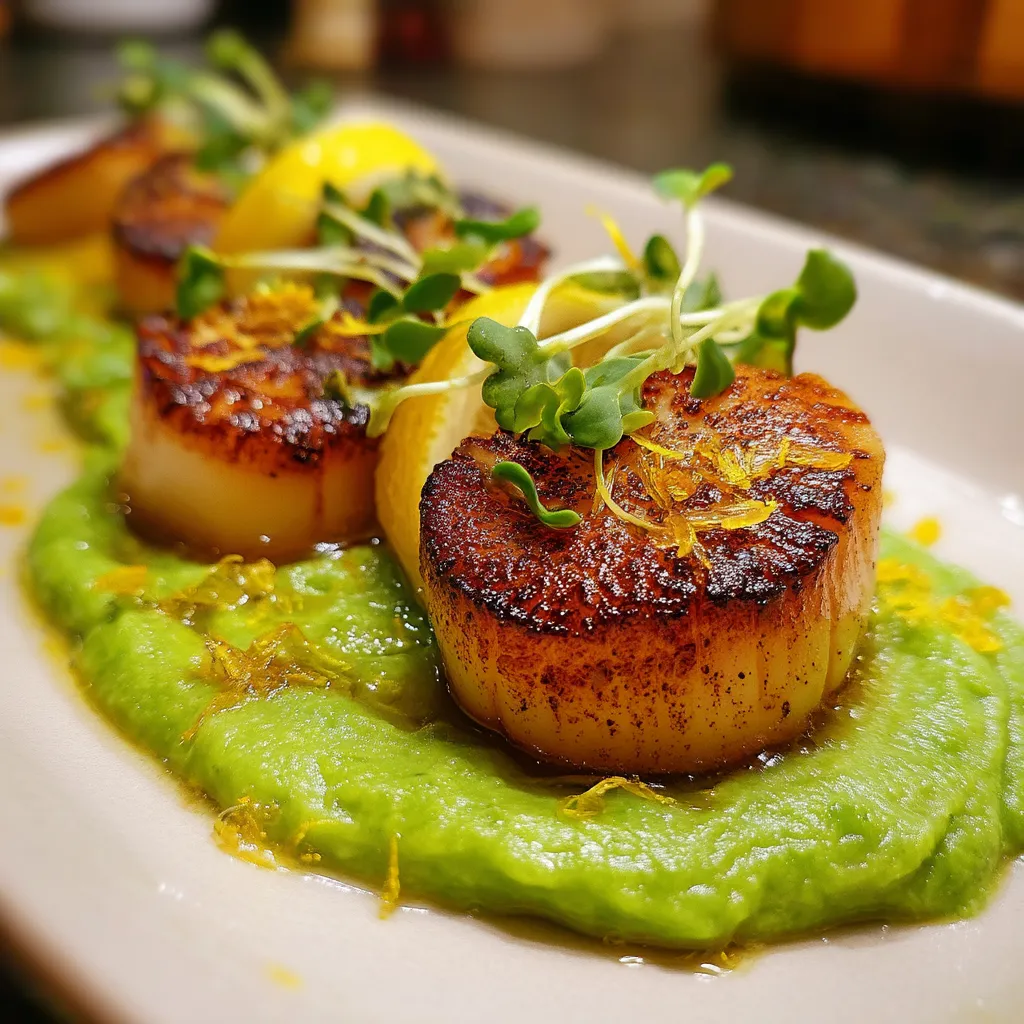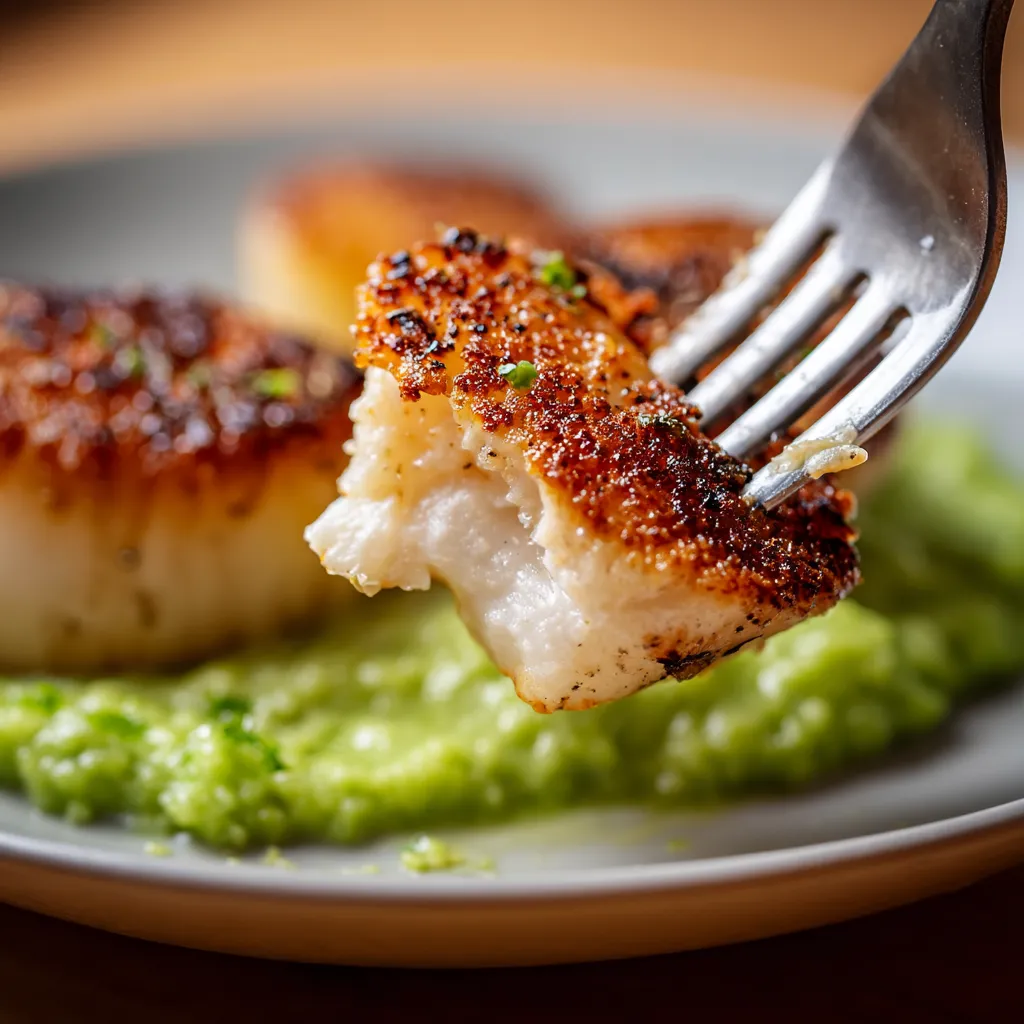 Save to Pinterest
Save to Pinterest This elegant seared scallops with pea purée recipe transforms simple ingredients into a restaurant-quality dish in just 25 minutes. The contrast between the caramelized scallops and vibrant, velvety pea purée creates a stunning presentation that's as delicious as it is beautiful.
I discovered this recipe while trying to recreate a memorable anniversary dinner, and it's become my go-to dish whenever I want to make someone feel special without spending hours in the kitchen.
Ingredients
- For the Pea Purée
- Frozen peas: 2 cups, perfect for year round availability and consistent sweetness
- Small shallot: 1, finely chopped, provides a subtle onion flavor without overpowering the delicate peas
- Unsalted butter: 1 tbsp, adds richness and helps bloom the shallot flavors
- Vegetable or chicken stock: 1/4 cup, thins the purée while adding depth
- Heavy cream: 2 tbsp, creates silky texture and adds luxurious mouthfeel
- Salt and white pepper: White pepper keeps the bright green color pristine
- Lemon juice: 1 tsp, brightens and balances the sweetness of the peas
- For the Scallops
- Large sea scallops: 12, look for dry packed scallops without added chemicals for best searing
- Salt and freshly ground black pepper: Enhances the natural sweetness of scallops
- Olive oil: 1 tbsp, provides high heat searing capacity
- Unsalted butter: 1 tbsp, adds richness and helps create golden crust
- Optional Garnishes
- Microgreens or pea shoots: Add visual appeal and fresh crunch
- Lemon zest: Provides aromatic citrus notes
- Cracked pink peppercorns: Add subtle heat and beautiful color
Step-by-Step Instructions
- Prepare the Pea Purée Base:
- Melt butter in a saucepan over medium heat until it begins to foam slightly. Add the finely chopped shallot and sauté for about 2 minutes until translucent and fragrant but not browned. Stir occasionally to ensure even cooking.
- Cook the Peas:
- Add the frozen peas directly to the shallots along with the stock. Bring the mixture to a gentle simmer and cook for 3 to 4 minutes until the peas are tender but still vibrantly green. Avoid overcooking as this will dull both color and flavor.
- Blend to Perfection:
- Transfer the warm pea mixture to a blender. Add the heavy cream, lemon juice, and season with salt and white pepper. Blend on high speed for at least 1 minute until completely smooth and velvety. Check consistency and add a splash more stock if needed. Return to the pan and keep warm over very low heat.
- Prepare the Scallops:
- Thoroughly pat scallops dry with paper towels, this is crucial for proper searing. Remove the small side muscle if present; it will be a rectangular tag on one side. Season both sides generously with salt and pepper just before cooking.
- Sear to Golden Perfection:
- Heat olive oil in a large nonstick or cast iron skillet over high heat until shimmering and nearly smoking. Place scallops in the pan with space between each one. Cook undisturbed for exactly 2 minutes to develop a deep golden crust. Resist the urge to move them during this time.
- Finish the Scallops:
- Flip each scallop using tongs and immediately add butter to the pan. As the butter melts, tilt the pan slightly and use a spoon to baste the scallops with the butter for another 1 to 2 minutes. The scallops should be opaque and spring back slightly when pressed.
- Plate with Precision:
- Spoon a generous pool of warm pea purée onto each plate, gently spreading it with the back of a spoon. Arrange 3 scallops per serving on top of the purée. Add garnishes if desired and serve immediately while hot.
 Save to Pinterest
Save to Pinterest The secret to this dish is respecting the simplicity of the ingredients. I learned from my grandmother that peas need minimal cooking to maintain their natural sweetness. The first time I made this for my partner, they declared it better than any restaurant version we'd had.
Perfect Scallop Selection
When buying scallops, look specifically for dry or dry packed varieties. Wet scallops are treated with a phosphate solution that makes them absorb water, making proper searing nearly impossible. Dry scallops have a naturally sweet flavor and caramelize beautifully. Fresh scallops should smell clean and oceanic, never fishy. The color should be slightly off white to pale beige, never pure bright white which indicates chemical treatment.
Make Ahead Options
The pea purée can be made up to 2 days ahead and refrigerated in an airtight container. Reheat gently in a saucepan with a splash of stock or water, stirring frequently. The scallops, however, must be cooked just before serving. Cooked scallops don’t reheat well as they become tough and rubbery. If you need to prepare components ahead for entertaining, have everything ready and just sear the scallops at the last minute.
Seasonal Variations
In late spring and early summer, substitute fresh peas for an even more vibrant flavor. You’ll need to blanch them briefly in boiling salted water before adding to the shallots. During winter months, enhance the purée with a touch of mint or basil for brightness. For a fall version, try adding a small amount of roasted butternut squash to the pea purée for a seasonal twist that complements the scallops beautifully.
 Save to Pinterest
Save to Pinterest Common Recipe Questions
- → How do I get a perfect sear on scallops?
The key to perfectly seared scallops is thoroughly patting them dry with paper towels before cooking. Use a hot pan with oil that's almost smoking, place scallops without crowding, and don't move them for 2 minutes to develop a golden crust. Finish with butter basting and remove as soon as they're just firm.
- → Can I make the pea purée ahead of time?
Yes, the pea purée can be made up to 24 hours in advance and stored in an airtight container in the refrigerator. Reheat gently in a saucepan over low heat, adding a splash of stock if needed to restore the smooth consistency.
- → What can I substitute for heavy cream to make this dairy-free?
For a dairy-free version, substitute the butter with olive oil or a plant-based butter, and replace heavy cream with full-fat coconut milk or cashew cream. These alternatives will maintain the creamy texture while accommodating dietary restrictions.
- → How do I know when scallops are perfectly cooked?
Perfectly cooked scallops should be opaque throughout with a slight translucence in the very center. They should feel slightly firm but still tender when pressed. Typically, this takes just 2 minutes on the first side and 1-2 minutes on the second side. Overcooked scallops become tough and rubbery.
- → What wines pair best with this dish?
The sweetness of the peas and delicate flavor of scallops pair beautifully with crisp, unoaked white wines. Excellent choices include Sauvignon Blanc, Pinot Grigio, Albariño, or a dry Riesling. For something special, try a high-quality Chablis or Sancerre.
- → Can I use fresh peas instead of frozen?
Absolutely! Fresh peas can be substituted for frozen in equal amounts. They may require slightly longer cooking time (4-5 minutes) until tender. Fresh peas often have a sweeter flavor that enhances the purée, though high-quality frozen peas provide excellent results year-round.